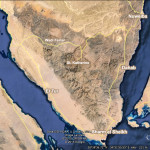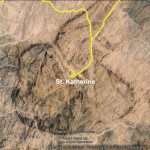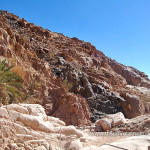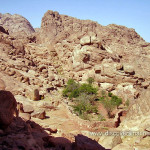Geographical features: Jidda / Dyke (Dike)
Originally posted on February 7, 2015
The whole southern tip of the Sinai Peninsula is a mountainous area, while the High Mountain Region proper, sometimes called the Central High Mountains, is the area in the middle around the town of St. Katherine. (See Google Earth screenshots below.) Up to 80% of the massif is granite of different types formed as far back as 600 million years, but there are also mountains that are made of newer, about 10 million year-old black volcanic rock. Sandstone and limestone are found north of the mountainous tip, forming surrealistic rock formations, sandy plains and eroded layered plateaus. In the mountainous area red granite and black volcanic mountains are often found together, as we can see with the Jebel Safsafa-Mt. Sinai, the Jebel Raba-Jebel Ahmar-Mt. Katharina or the Jebel Abu Mahashur-Jebel Abbas Basha ranges. In each case much of the mass of the mountains is made of hard and smooth red granite, but the famous peaks are actually softer crumbling black rock. They were formed where the granite massif cracked and volcanic magma pushed through the cracks from below which then cooled and solidified.
The same process created the curious stripes that crisscross the ranges, which you can see wherever you go in the mountainous areas of Sinai. These stripes, varying in colour but usually dark, are intrusions, that is magmatic rock that seeped in the cracks as explained just before. In geology they are called dykes (in American dikes) and locally they are known as jidda which means grandmother – “the nurturer, the nourisher”. Since they are made of softer rock than the surrounding granite, they erode faster often forming gullies, cuttings or long depressions functioning as natural channels. Water tends to gather in the porous dykes and the Bedouin usually dig the wells in them at certain points. Also more plants grow in the dykes, because of the availability of water and the softer terrain. Dykes are less common in sandy areas but you do find some nice examples. When the surrounding area is softer, dykes stand above the surface, often forming long hills as seen across the plain of Elu el Ajramiya north of St. Katherine. Dykes can run for many kilometres, cutting through mountains, wadi floors and basins. St Katherine and the High Mountain Region are actually encircled by a dyke of massive proportions: this circular dyke is well visible on satellite photos (marked with a red line on the Google Earth screenshots).
You can spot dykes just outside Dahab, in Wadi Gnai or Abu Galum, inland from the Nuweiba-Taba coast or driving through Wadi Feiran, and of course in the high mountains. You can see some good examples of dykes on the following photos, including two of my favourites, Abu Jidda and El Freish.
The same process created the curious stripes that crisscross the ranges, which you can see wherever you go in the mountainous areas of Sinai. These stripes, varying in colour but usually dark, are intrusions, that is magmatic rock that seeped in the cracks as explained just before. In geology they are called dykes (in American dikes) and locally they are known as jidda which means grandmother – “the nurturer, the nourisher”. Since they are made of softer rock than the surrounding granite, they erode faster often forming gullies, cuttings or long depressions functioning as natural channels. Water tends to gather in the porous dykes and the Bedouin usually dig the wells in them at certain points. Also more plants grow in the dykes, because of the availability of water and the softer terrain. Dykes are less common in sandy areas but you do find some nice examples. When the surrounding area is softer, dykes stand above the surface, often forming long hills as seen across the plain of Elu el Ajramiya north of St. Katherine. Dykes can run for many kilometres, cutting through mountains, wadi floors and basins. St Katherine and the High Mountain Region are actually encircled by a dyke of massive proportions: this circular dyke is well visible on satellite photos (marked with a red line on the Google Earth screenshots).
You can spot dykes just outside Dahab, in Wadi Gnai or Abu Galum, inland from the Nuweiba-Taba coast or driving through Wadi Feiran, and of course in the high mountains. You can see some good examples of dykes on the following photos, including two of my favourites, Abu Jidda and El Freish.



















